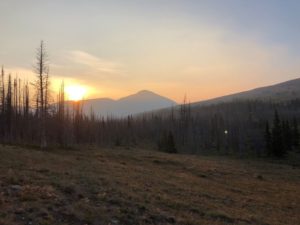
At first glance, these toothpick forests of the Scapegoat Wilderness in Montana want to invade me with fear and loneliness and hang me out to dry in the sun under identical trees across the hillsides. Their haggard branches reach weakly into the air before sloping downward into submission. They unsettle me with their lifeless stature, and they incessantly bugged me when we first entered this torn landscape, but I learned an important lesson that helped me overcome this:
Look down, not up.
First of all, I carry a cumbersome backpack that constantly threatens my balance, so I need to see exactly where I’m placing my feet or else I will surely find a way to break an ankle. Second, life in these burnt lands is always found at your feet. The magic lies in the greenery, and even when all the needles are lost from the pines, ashes of those needles provide nutrients necessary for the blossoming wildflowers covering the forest floor. Fire is but a part of the cycle here, as death gives way to life. Fire recycles resources by returning nutrients to the soil, allowing light to illuminate the ground while freeing up space for life to grow in its aftermath.
Although my journey at WRFI is barely two weeks old, I feel as though the hours spent backpacking through miles of forests decimated by fire are branded into my brain. Even in broad daylight, the naked trees waver ominously and threaten to topple at the brush of a hand. This land knows destruction, and all of us can feel that in the remains of conifers around us. However, it offers insight that I don’t see around my hometown in western Wisconsin, while also proposing a new perspective.
My homeland is full of well-groomed farmlands, temperate forests, and rivers undisturbed by natural disasters. The natural landscape rarely changes unless it is bent to human development. Our choices for purposing land often invoke the degradation or destruction of the environment in the area, without much hope for recovery. Lands less-perturbed by humankind, like the forests and rivers near my home, always offer refuge from urban onslaught. But these landscapes never seem to change. Trees grow old, plump flowers pop at their respective time of season, and the same songbirds flit from tree to tree every day. For all of my life, these little areas were wonderlands that I could always count on.
In the wild lands of Montana, my eyes develop a more tuned-in sensitivity to life after fire every day we spend out here on the trail. These lands are a scattered timeline of fires, and it doesn’t take a very keen eye to identify the stages of the recovery process. There are three stages to the development of an ecosystem after a major disturbance, like a fire, destroys the preexisting habitat: primary succession, secondary succession, and the climax community.
Most of the areas I see are in the primary stages of their recovery which can take decades to complete, but even so, much variety exists between these fresh landscapes. Some areas feature pines growing among their broken forefathers, all of these young trees reaching the same height since they were seeded at the same time right after the fire cooled and the ashes settled. Other locations boast no trees yet, for fire ravaged that location more recently. This allows room for the glorious fireweed to dominate. Fireweed, a pioneer species, is one of the very first plants to claim a freshly burned hillside in the Rocky Mountains. They sprout a long stem and bloom vibrant purple flowers in August and their leaves turn bright red. In fact, as I write this I am perched in the grandest field of brilliant fireweed I have laid eyes on.
The more familiar the concept of disturbance becomes to me, the more hope I feel about the future of mankind and our wild spaces. Whether a disturbance is natural or human-induced, it is all part of a grand cycle. Time is the only difference between them, for natural disasters often clear landscapes for new growth while humans develop and consume land, taking away space instead of freeing it up. Despite this, nothing lasts forever, and nothing remains the same. It’s important to remember that nature still rules over us in the same way the forests of the Scapegoat fall. Hurricanes and earthquakes disturb our foundations and sweep away buildings. Droughts and floods demolish communities and inspire wars. We try to manage nature without keeping in mind that we, too, are just as subject to disturbance, death, and new life as any other life on this planet.
In my mind I see the miles of pavement in my hometown, the Walmart, the massive high school, and the scummy ponds. This seems to fit my idea of destruction more readily than a massive forest fire, but the thought doesn’t make me unhappy, either. I can travel a few miles north out of town in my memories and stand at the observation deck at the waterfowl production lands to admire the recently restored prairie and oakland savanna. I can watch new life sprout in the spring after a prescribed fire torches the land anew. I can travel even further north to the next village and watch as vines creep up the brick walls of the post office and the antique store; I see the stalks of grass and dandelions poke through cracks in the sidewalks. For everything we disturb, life begins to mosey its way into our projects of the past, and we help the world continue in its cycle of persistent change.